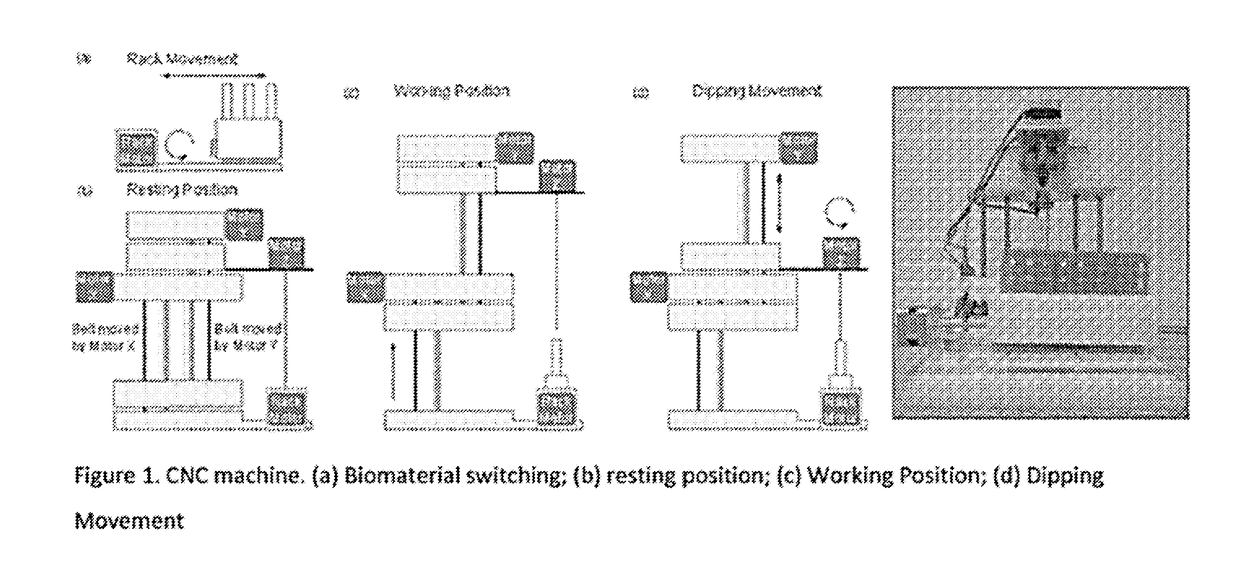Automated fabrication of layer-by-layer tissue engineered complex tubes
a tissue engineered complex, layer-by-layer technology, applied in the direction of prosthesis, blood vessels, other domestic articles, etc., can solve the problems of not meeting the physiological requirements of sdbv, posing a serious risk of myocardial infarction, and resting ,
- Summary
- Abstract
- Description
- Claims
- Application Information
AI Technical Summary
Benefits of technology
Problems solved by technology
Method used
Image
Examples
example 1
[0064]Robotic Device
[0065]A computerized numerical control (CNC) machine that allows the controlled elevation, drop and rotation of a metal mandrel was designed and constructed in our laboratory and it is illustrated in FIG. 1. The robot consists of several platforms that can slide vertically, guided by steel rod, and moved by pulleys, belts and 2 NEMA 16 stepper motors (SM-42BYG011-25, Mercury Motor, China). The first motor, denominated as Motor X, allows the system to go from rest position (FIG. 1(b)) to working position (FIG. 1(c)); whereas the second motor, Motor Y, controls the mandrel dipping while the rotational movement is performed by a third NEMA 16 stepper motor, Motor Z, shown in FIG. 1(d).
[0066]Motors are controlled by an electronic circuit using different Open Source elements. The hardware consists of an Arduino UNO R3 microprocessor (50, Adafruit, USA) connected to a gShield v.5 (1750, Adafruit) specially designed to allow easy control of 3 bipolar stepper motors simu...
example 2
Robotic Device (as Described in Example 1)
Preparation of GeIBMa-Alginate Solution.
[0108]Methacrylated bovine gelatin, or GeIBMa, was synthesized by mixing bovine gelatin (Bloom 220, Rousselot, Netherlands) and methacrylic anhydride to a final concentration of 8% (v / v) as previously dissolved in PBS 1× (pH 7.4) at 60° C. for 3 hrs. as previously described (Nichol et al. 2010; Van Den Bulcke et al. 2000). Three stock solutions were prepared. GeIBMa stock solution was prepared by dissolving freeze dried GeIBMa in PBS 1× at 40° C. at a concentration of 20% (w / v). Alginate stock solution was prepared by dissolving medium viscosity sodium alginate (A2033, Sigma, USA) in PBS 1× at 60° C. at a concentration of 2% (w / v). The PI stock solution was prepared by dissolving 2-Hydroxy-4′-(2-hydroxyethoxy)-2-methylpropiophenone (410896, Sigma, USA) in PBS 1× at 85° C. until fully dissolved. The GeIBMa-alginate solution was prepared by mixing the three stock solutions to a final concentration on 10%...
PUM
| Property | Measurement | Unit |
|---|---|---|
| Diameter | aaaaa | aaaaa |
| Diameter | aaaaa | aaaaa |
| Thickness | aaaaa | aaaaa |
Abstract
Description
Claims
Application Information
 Login to View More
Login to View More - R&D
- Intellectual Property
- Life Sciences
- Materials
- Tech Scout
- Unparalleled Data Quality
- Higher Quality Content
- 60% Fewer Hallucinations
Browse by: Latest US Patents, China's latest patents, Technical Efficacy Thesaurus, Application Domain, Technology Topic, Popular Technical Reports.
© 2025 PatSnap. All rights reserved.Legal|Privacy policy|Modern Slavery Act Transparency Statement|Sitemap|About US| Contact US: help@patsnap.com



